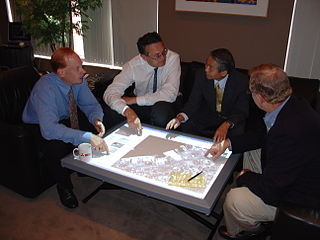Related Research Articles

In human–computer interaction, WIMP stands for "windows, icons, menus, pointer", denoting a style of interaction using these elements of the user interface. Other expansions are sometimes used, such as substituting "mouse" and "mice" for menus, or "pull-down menu" and "pointing" for pointer.
The following outline is provided as an overview of and topical guide to human–computer interaction:

Ben Shneiderman is an American computer scientist, a Distinguished University Professor in the University of Maryland Department of Computer Science, which is part of the University of Maryland College of Computer, Mathematical, and Natural Sciences at the University of Maryland, College Park, and the founding director (1983-2000) of the University of Maryland Human-Computer Interaction Lab. He conducted fundamental research in the field of human–computer interaction, developing new ideas, methods, and tools such as the direct manipulation interface, and his eight rules of design.
Affective design describes the design of user interfaces in which emotional information is communicated to the computer from the user in a natural and comfortable way. The computer processes the emotional information and adapts or responds to try to improve the interaction in some way. The notion of affective design emerged from the field of human–computer interaction (HCI), specifically from the developing area of affective computing. Affective design serves an important role in user experience (UX) as it contributes to the improvement of the user's personal condition in relation to the computing system. The goals of affective design focus on providing users with an optimal, proactive experience. Amongst overlap with several fields, applications of affective design include ambient intelligence, human–robot interaction, and video games.

The Human–Computer Interaction Institute (HCII) is a department within the School of Computer Science at Carnegie Mellon University (CMU) in Pittsburgh, Pennsylvania. It is considered one of the leading centers of human–computer interaction research, and was named one of the top ten most innovative schools in information technology by Computer World in 2008. For the past three decades, the institute has been the predominant publishing force at leading HCI venues, most notably ACM CHI, where it regularly contributes more than 10% of the papers. Research at the institute aims to understand and create technology that harmonizes with and improves human capabilities by integrating aspects of computer science, design, social science, and learning science.

The Human–Computer Interaction Lab (HCIL) at the University of Maryland, College Park is an academic research center specializing in the field of human-computer interaction (HCI). Founded in 1983 by Ben Shneiderman, it is one of the oldest HCI labs of its kind. The HCIL conducts research on the design, implementation, and evaluation of computer interface technologies. Additional research focuses on the development of user interfaces and design methods. Primary activities of the HCIL include collaborative research, publication and the sponsorship of open houses, workshops and annual symposiums.
John Millar Carroll is an American distinguished professor of Information Sciences and Technology at Pennsylvania State University, where he previously served as the Edward Frymoyer Chair of Information Sciences and Technology. Carroll is perhaps best known for his theory of Minimalism in computer instruction, training, and technical communication.
Human–computer information retrieval (HCIR) is the study and engineering of information retrieval techniques that bring human intelligence into the search process. It combines the fields of human-computer interaction (HCI) and information retrieval (IR) and creates systems that improve search by taking into account the human context, or through a multi-step search process that provides the opportunity for human feedback.

Human–computer interaction (HCI) is research in the design and the use of computer technology, which focuses on the interfaces between people (users) and computers. HCI researchers observe the ways humans interact with computers and design technologies that allow humans to interact with computers in novel ways. A device that allows interaction between human being and a computer is known as a "Human-computer Interface (HCI)".
Steve Whittaker is a Professor in Human-Computer Interaction at the University of California Santa Cruz. He is best known for his research at the intersection of computer science and social science in particular on computer mediated communication and personal information management. He is a Fellow of the ACM, and winner of the CSCW 2018 "Lasting Impact" award. He also received a Lifetime Research Achievement Award from SIGCHI, is a Member of the SIGCHI Academy. He is Editor of the journal Human Computer Interaction..

The DiamondTouch table is a multi-touch, interactive PC interface product from Circle Twelve Inc. It is a human interface device that has the capability of allowing multiple people to interact simultaneously while identifying which person is touching where. The technology was originally developed at Mitsubishi Electric Research Laboratories (MERL) in 2001 and later licensed to Circle Twelve Inc in 2008. The DiamondTouch table is used to facilitate face-to-face collaboration, brainstorming, and decision-making, and users include construction management company Parsons Brinckerhoff, the Methodist Hospital, and the US National Geospatial-Intelligence Agency (NGA).

Marilyn Mantei Tremaine is an American computer scientist. She is an expert in human–computer interaction and considered a pioneer of the field.
Design fiction is a design practice aiming at exploring and criticising possible futures by creating speculative, and often provocative, scenarios narrated through designed artifacts. It is a way to facilitate and foster debates, as explained by futurist Scott Smith: "... design fiction as a communication and social object creates interactions and dialogues around futures that were missing before. It helps make it real enough for people that you can have a meaningful conversation with".
Feminist HCI is a subfield of human-computer interaction that focuses on helping the field of HCI build interactions that pay attention to gender, equity, and social justice in research and in the design process.

Jacob O. Wobbrock is a Professor in the University of Washington Information School and, by courtesy, in the Paul G. Allen School of Computer Science & Engineering at the University of Washington. He is Director of the ACE Lab, founding Co-Director of the CREATE center, and a founding member of the DUB Group and the MHCI+D degree program.
Joëlle Coutaz is a French computer scientist, specializing in human-computer interaction (HCI). Her career includes research in the fields of operating systems and HCI, as well as being a professor at the University of Grenoble. Coutaz is considered a pioneer in HCI in France, and in 2007, she was awarded membership to SIGCHI. She was also involved in organizing CHI conferences and was a member on the editorial board of ACM Transactions on Computer-Human Interaction.
Sharon Oviatt is an internationally recognized computer scientist, professor and researcher known for her work in the field of human–computer interaction on human-centered multimodal interface design and evaluation.
Susanne Bødker is a Danish computer scientist known for her contributions to human–computer interaction, computer-supported cooperative work, and participatory design, including the introduction of activity theory to human–computer interaction. She is a professor of computer science at Aarhus University, and a member of the CHI Academy.

Shumin Zhai is an American-Canadian-Chinese Human–computer interaction (HCI) research scientist and inventor. He is known for his research specifically on input devices and interaction methods, swipe-gesture-based touchscreen keyboards, eye-tracking interfaces, and models of human performance in human-computer interaction. His studies have contributed to both foundational models and understandings of HCI and practical user interface designs and flagship products. He previously worked at IBM where he invented the ShapeWriter text entry method for smartphones, which is a predecessor to the modern Swype keyboard. Dr. Zhai's publications have won the ACM UIST Lasting Impact Award and the IEEE Computer Society Best Paper Award, among others, and he is most known for his research specifically on input devices and interaction methods, swipe-gesture-based touchscreen keyboards, eye-tracking interfaces, and models of human performance in human-computer interaction. Dr. Zhai is currently a Principal Scientist at Google where he leads and directs research, design, and development of human-device input methods and haptics systems.

Thorsten O. Zander is a German scientist who introduced the concept of passive brain-computer interface. He co-founded Zander Labs, a German-Dutch company in the field of passive brain computer interface (pBCI) and neuro-adaptive technology (NAT).
References
- 1 2 3 Massimi, Michael; Andrea Charise (2009). Dying, death, and mortality: towards thanatosensitivity in HCI. CHI EA '09: Proceedings of the 27th International Conference Extended Abstracts on Human Factors in Computing Systems. pp. 2459–2468. doi:10.1145/1520340.1520349. ISBN 9781605582474. S2CID 14069413.
- 1 2 Lindley, Siân E.; Eduardo H. Calvillo Gámez; Juan José Gámez Leija (April 2010). "Remembering rituals of remembrance: Capturing Xantolo through SenseCam". CHI 2010 Workshop on HCI at the End of Life.
- ↑ "Yahoo denies family access to dead marine's e-mail". CNET News. December 21, 2004.
- ↑ Wendy Moncur; Annalu Waller (2010). "Digital Inheritance". RCUK Digital Futures 2010.
{{cite journal}}: Cite journal requires|journal=(help) - ↑ Wiley, Cyndi; Wang, Yun; Musselman, Ryan; Krumm, Beverly; Stephanidis, Constantine (2011). "Connecting Generations: Preserving Memories with Thanatosensitive Technologies". In Constantine Stephanidis (ed.). HCI International 2011 – Posters' Extended Abstracts . Berlin, Heidelberg: Springer-Verlag Berlin Heidelberg. pp. 474–478. doi:10.1007/978-3-642-22098-2_95. ISBN 978-3-642-22098-2.
- ↑ "HCI at the end of life: Understanding death, dying, and the digital" (PDF). Proc. CHI 2010 Extended Abstracts, 4477-4480.
- ↑ Carla Sofka; Kathleen Gilbert; Illene Noppe (2012). Thanatechnology: Dying, Death, and Grief in an Online Universe. Springer Publishing Company. ISBN 978-0-8261-0732-9.
- ↑ Jed Brubaker; Janet Vertesi. "Death and the Social Network". Paper presented at the CHI 2010 workshop HCI at the End of Life. Archived from the original on 2012-07-04. Retrieved 2017-10-31.
{{cite journal}}: Cite journal requires|journal=(help) - ↑ Braman, James; Dudley, Alfreda; Vincenti, Giovanni (2011). "Death, Social Networks and Virtual Worlds: A Look into the Digital Afterlife". 2011 Ninth International Conference on Software Engineering Research, Management and Applications. pp. 186–192. doi:10.1109/SERA.2011.35. ISBN 978-1-4577-1028-5. S2CID 11685020.